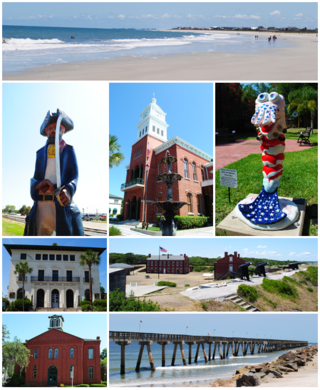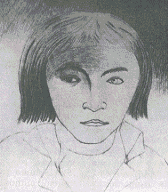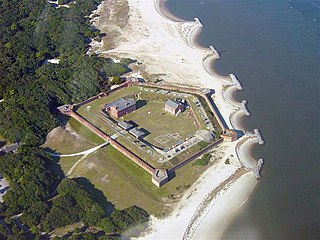
Nassau County is the northeasternmost county of the U.S. state of Florida. According to the July 2022 United States Census analysis, the county's population was 97,899.

Fernandina Beach is a city in northeastern Florida and the county seat of Nassau County, Florida, United States. It is the northernmost city on Florida's Atlantic coast, situated on Amelia Island, and is one of the principal municipalities comprising Greater Jacksonville. The area was first inhabited by the Timucuan Indian people. Known as the "Isle of 8 Flags", Amelia Island has had the flags of the following nations flown over it: France, Spain, Great Britain, Spain (again), the Republic of East Florida (1812), the Republic of the Floridas (1817), Mexico, the Confederate States of America, and the United States.

East Florida was a colony of Great Britain from 1763 to 1783 and a province of Spanish Florida from 1783 to 1821. Great Britain gained control of the long-established Spanish colony of La Florida in 1763 as part of the treaty ending the French and Indian War. Deciding that the territory was too large to administer as a single unit, Britain divided Florida into two colonies separated by the Apalachicola River: East Florida with its capital in St. Augustine and West Florida with its capital in Pensacola. East Florida was much larger and comprised the bulk of the former Spanish territory of Florida and most of the current state of Florida. It had also been the most populated region of Spanish Florida, but before control was transferred to Britain, most residents – including virtually everyone in St. Augustine – left the territory, with most migrating to Cuba.

General Gregor MacGregor was a Scottish soldier, adventurer, and confidence trickster who attempted from 1821 to 1837 to draw British and French investors and settlers to "Poyais", a fictional Central American territory that he claimed to rule as "Cazique". Hundreds invested their savings in supposed Poyaisian government bonds and land certificates, while about 250 emigrated to MacGregor's invented country in 1822–23 to find only an untouched jungle; more than half of them died. Seen as a contributory factor to the "Panic of 1825", MacGregor's Poyais scheme has been called one of the most brazen confidence tricks in history.

Amelia Island is a part of the Sea Islands chain that stretches along the East Coast of the United States from South Carolina to Florida; it is the southernmost of the Sea Islands, and the northernmost of the barrier islands on Florida's Atlantic coast. Lying in Nassau County, Florida, it is 13 miles (21 km) long and approximately 4 miles (6.4 km) wide at its widest point. The communities of Fernandina Beach, Amelia City, and American Beach are located on the island.

Louis-Michel Aury was a French privateer operating in the Gulf of Mexico and the Caribbean during the early 19th century.

Fort Clinch is a 19th-century masonry coastal fortification, built as part of the Third System of seacoast defense conceived by the United States. It is located on a peninsula near the northernmost point of Amelia Island in Nassau County, Florida. The fort lies to the northeast of Fernandina Beach at the entrance to the Cumberland Sound, in the northeast part of the state. Today it is included within the boundaries of Fort Clinch State Park.

The Amelia Island affair was an episode in the history of Spanish Florida.
Jared Irwin was a United States Representative from Pennsylvania.

The Arbuthnot and Ambrister incident occurred in 1818 during the First Seminole War. American General Andrew Jackson invaded Spanish Florida and captured and executed Alexander George Arbuthnot and Robert C. Ambrister, two British citizens charged with aiding Seminole and Creek Indians against the United States.

The Original Town of Fernandina Historic Site, also known as "Old Town", is a historic site in Fernandina Beach, Florida, located on Amelia Island. It is roughly bounded by Towngate Street, Bosque Bello Cemetery, Nassau, Marine, and Ladies Streets. On January 29, 1990, it was added to the U.S. National Register of Historic Places as a historic site. Lying north of the Fernandina Beach Historic District, it is accessible from North 14th Street.
Events from the year 1818 in the United States.
The Patriot War was an attempt in 1812 to foment a rebellion in Spanish East Florida with the intent of annexing the province to the United States. The invasion and occupation of parts of East Florida had elements of filibustering, but was also supported by units of the United States Army, Navy and Marines, and by militia from Georgia and Tennessee. The rebellion was instigated by General George Mathews, who had been commissioned by United States President James Madison to accept any offer from local authorities to deliver any part of the Floridas to the United States, and to prevent the reoccupation of the Floridas by Great Britain. The rebellion was supported by the Patriot Army, which consisted primarily of citizens of Georgia. The Patriot Army, with the aid of U.S. Navy gunboats, was able to occupy Fernandina and parts of northeast Florida, but never gathered enough strength to attack St. Augustine. United States Army troops and Marines were later stationed in Florida in support of the Patriots. The occupation of parts of Florida lasted over a year, but after United States military units were withdrawn and Seminoles entered the conflict, the Patriots dissolved.

Fort San Carlos was a military structure built in 1816 to defend the Spanish colonial town of Fernandina, Florida, now called Old Town, which occupied a peninsula on the northern end of Amelia Island. The fort, a lunette fortification, stood on the southwest side of the town next to the harbor, on a bluff overlooking the Amelia River. It was made of wood and earthworks, backed with a wooden palisade on the east side, and armed with an eight or ten gun battery. Two blockhouses protected access by land on the south, while the village was surrounded with military pickets. An 1821 map of Fernandina shows that the street plan, laid out in 1811 in a grid pattern by the newly appointed Surveyor General of Spanish East Florida, George J. F. Clarke, today preserves nearly the same layout as that of 1821. The fort occupied the area bounded by the streets Calle de Estrada, Calle de White, and Calle de Someruelos. The structure itself has disappeared and only traces remain in what is now Fernandina Plaza Historic State Park.

George J. F. Clarke was one of the most prominent and active men of East Florida during the Second Spanish Period. As a friend and trusted advisor of the Spanish governors of the province from 1811 to 1821, he was appointed to several public offices under the colonial regime, including that of surveyor general.
The Port of Fernandina is located on Florida's Atlantic coast. It is used for terminal service for pulp and paper as well as steel exports, machinery, auto parts, chemicals, beverages, chemicals, building materials and food products. Container lines from the port serve routes to Colombia, Venezuela, the Dominican Republic, Haiti, Jamaica, Aruba, Curaçao and Bermuda.
Enrique White was an Irish-born Spanish soldier who served as Governor of West Florida and of East Florida.

Thomas Adams Smith was an American military officer and, later, a government official, in the first half of the 19th century. He commanded troops in the "Patriot War" in Spanish East Florida. He commanded the Regiment of Riflemen and then the Ninth Military Department. He was a slave owner. The city of Fort Smith, Arkansas, is named for Smith, although he never went to its location.

The Republic of East Florida, also known as the Republic of Florida or the Territory of East Florida, was a putative republic declared by insurgents against the Spanish rule of East Florida, most of whom were from Georgia. John Houstoun McIntosh was chosen as "Director" of the self-named Patriots in March, 1812, to receive formal Spanish capitulation at Amelia Island. In July, while under the occupation of U.S. forces, the Patriots created a constitution of government that provided for an executive office, a legislative council, and a court system. Under its provisions, on July 27 McIntosh was named "Director of the Territory of East Florida". He was later succeeded in that office by Gen. Buckner Harris. Patriots wished neither independence nor statehood in the United States; they desired annexation by the U.S., connoted by the word "Territory" in their name of the country, and as expressly declared by the delegates at their constitutional convention.

John Houston McIntosh, also sometimes spelled John Houstoun McIntosh, (1773-1836) was a wealthy planter in Georgia who helped lead a rebel group during the Patriot War in Florida.
















